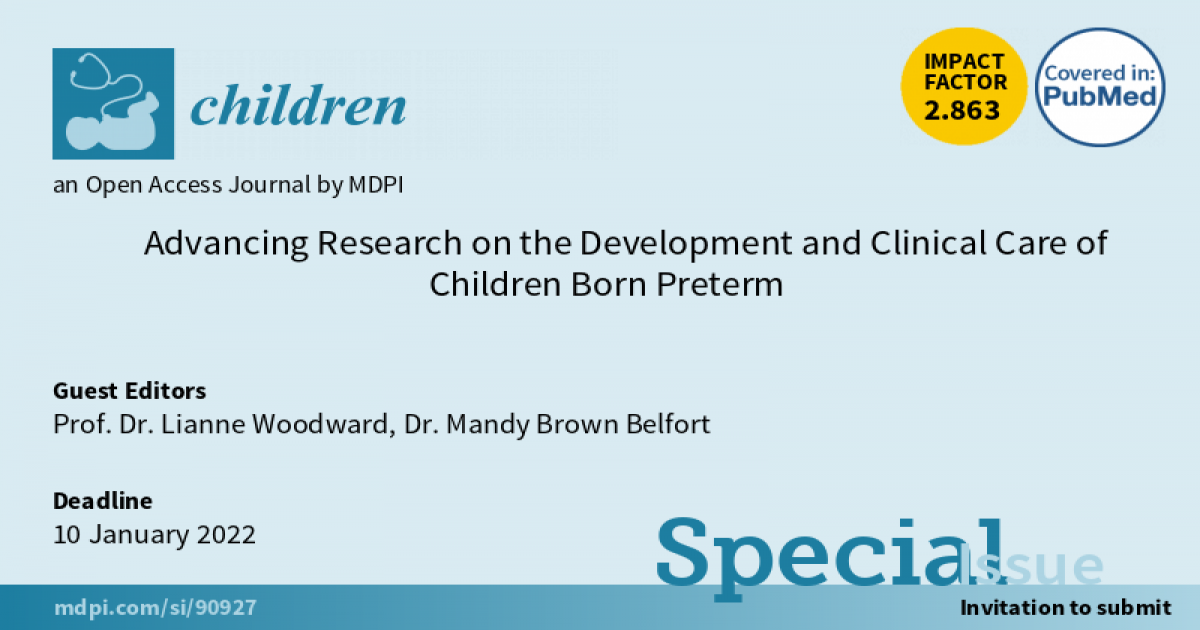- 2.1Impact Factor
- 3.8CiteScore
- 16 daysTime to First Decision
Advancing Research on the Development and Clinical Care of Children Born Preterm
This special issue belongs to the section “Pediatric Neonatology“.
Special Issue Information
Dear Colleagues,
Worldwide, around 15 million children are born preterm (<37 weeks of gestation) and over 2 million are born very preterm (<32 weeks of gestation). Whilst survival for these infants has improved considerably, at least in wealthier countries, rates of longer-term health and term neurodevelopmental problems remain high and stable. The focus of this Special Issue is the short- and long-term neurodevelopmental and family impacts of very preterm birth, and in particular the identification of modifiable factors and innovative intervention approaches to improve outcomes for very-preterm-born children and their families. Epidemiological, clinical, and translational research concerned with the following are welcome. A limited number of systematic reviews or meta-analyses may also be considered. All papers will be peer-reviewed.
- Epidemiological studies examining, in novel longitudinal ways, the health, neurodevelopmental, or family outcomes of children born very preterm and their families.
- Studies examining modifiable factors that may be targeted by interventions in the NICU or postnatally to improve outcomes for children born very preterm and their families. Potential factors may include environmental and/or clinical exposures or risk indicators during infant neonatal hospitalization, as well as factors relating to children’s post-discharge family and other psychosocial, early intervention, or educational experiences.
- Studies examining the effectiveness of innovations in the clinical management and support of very preterm born children and their families in the NICU and/or postnatally during childhood and adolescence. In the NICU, interventions may include novel approaches to early nutrition, neurorehabilitation, respiratory care, parent support, developmental, and family-centered care. Following discharge from hospital these may include pediatric, feeding/nutrition, neuropsychological, neuromotor, educational, or psychosocial interventions.
Prof. Dr. Lianne Woodward
Dr. Mandy Brown Belfort
Guest Editors
Manuscript Submission Information
Manuscripts should be submitted online at www.mdpi.com by registering and logging in to this website. Once you are registered, click here to go to the submission form. Manuscripts can be submitted until the deadline. All submissions that pass pre-check are peer-reviewed. Accepted papers will be published continuously in the journal (as soon as accepted) and will be listed together on the special issue website. Research articles, review articles as well as short communications are invited. For planned papers, a title and short abstract (about 250 words) can be sent to the Editorial Office for assessment.
Submitted manuscripts should not have been published previously, nor be under consideration for publication elsewhere (except conference proceedings papers). All manuscripts are thoroughly refereed through a single-blind peer-review process. A guide for authors and other relevant information for submission of manuscripts is available on the Instructions for Authors page. Children is an international peer-reviewed open access monthly journal published by MDPI.
Please visit the Instructions for Authors page before submitting a manuscript. The Article Processing Charge (APC) for publication in this open access journal is 2400 CHF (Swiss Francs). Submitted papers should be well formatted and use good English. Authors may use MDPI's English editing service prior to publication or during author revisions.
Keywords
- preterm
- child
- NICU
- outcome
- longitudinal

Benefits of Publishing in a Special Issue
- Ease of navigation: Grouping papers by topic helps scholars navigate broad scope journals more efficiently.
- Greater discoverability: Special Issues support the reach and impact of scientific research. Articles in Special Issues are more discoverable and cited more frequently.
- Expansion of research network: Special Issues facilitate connections among authors, fostering scientific collaborations.
- External promotion: Articles in Special Issues are often promoted through the journal's social media, increasing their visibility.
- e-Book format: Special Issues with more than 10 articles can be published as dedicated e-books, ensuring wide and rapid dissemination.

